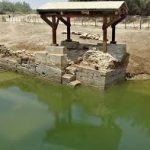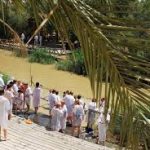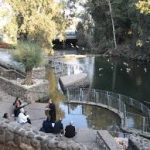The Baptism of Jesus
9 In those days Jesus came from Nazareth of Galilee and was baptized by John in the Jordan. 10 And just as he was coming up out of the water, he saw the heavens torn apart and the Spirit descending like a dove on him. 11 And a voice came from heaven, “You are my Son, the Beloved; with you I am well pleased.”
The Temptation of Jesus
12 And the Spirit immediately drove him out into the wilderness. 13 He was in the wilderness forty days, tempted by Satan; and he was with the wild beasts; and the angels waited on him.
The Beginning of the Galilean Ministry
14 Now after John was arrested, Jesus came to Galilee, proclaiming the good news of God, 15 and saying, “The time is fulfilled, and the kingdom of God has come near; repent, and believe in the good news.” [Mark 1:9-15, NRSV]
1. Bartolome Esteban Murillo.Baptism of Christ; 2. Shelter over remains of a church at the Al Maghtas Baptism Site (Alicia Bramlett); 3. Qasr el Yahud; 4. Yardenit Baptismal Site.
The River Jordan is a popular Israel tourist destination. Baptism at the Jordan River is also a popular Christian pilgrimage activity. The river being the very waters where John the Baptist baptized Jesus Christ, Christians piously treat any officially designated site as a sacred biblical site in Israel, daily arriving in huge bus-loads. Many of them even follow officially prescribed guidelines and pay the prescribed fees to experience baptism in the Jordan River.
There are competing claims by several sites for the status of authentic spot where Jesus was baptized at the River Jordan by John the Baptist. The two best known sites are: (a) on the Israeli side, the Yardenit Baptismal Site near Bet Yerah; and (b) on the Jordanian side, Al-Maghtas.
In terms of Christian tradition, there is no doubt that the Jordanian site deserves greater respect.
- The Jordan River flows 251 kilometers from the Sea of Galilee to the Dead Sea. It holds special significance in Judaism and Christianity. For the Jews, the emerging nation of the Moses-led forty- year desert-sojourn made up of the tribes of Israel crossed the river on dry ground to enter the Promised Land with Joshua (Joshua 3:14-17). For Christians, Jesus of Nazareth was baptized by John the Baptist (Mark 1:9-11) in the waters of the Jordan River.
- Traditionally, since at least the Byzantine period, Christians have accepted and venerated the baptismal site, known as Al-Maghtas (meaning “baptism” or “immersion” in Arabic), as the site of the baptism of Jesus by John the Baptist. Also known as Baptism Site “Bethany beyond the Jordan” (Al-Maghtas), it was a name historically used for the pilgrimage site on both sides of the river. Now, Al-Maghtas only refers to the Jordanian side, that is, east of the river only.
- Tradition holds that the Israelites crossed the river at the spot of Al-Maghtas, and Elijah the Prophetascended to heaven from here as well.
- At the same area, but specifically on the western side of the river, is the site of Qasr el Yayud (meaning “Castle of the Jews”), on account of the nearby Greek Orthodox Monastery of St John the Baptist which has a Castle-like appearance. It is located in the West Bank, near Jericho and is part of the Jericho Governorate of Palestine.
- Since Al-Maghtasin Jordan shows the earliest religious structures connected with baptism or religious baths on the Eastern part of the Jordan, it is considered to be the original location of the baptism of Jesus and the ministry of John the Baptist. Al-Maghtas also includes two principal archaeological areas: the remnants of a monastery on a mound known as Jabal Mar-Elias (Elijah‘s Hill); and an area close to the river with remains of churches, baptism ponds and pilgrim and hermit dwellings. In 2015, the UNESCO declared Al Maghtas together with Jabal Mar-Elias (Elijah’s Hill) on the East bank a world heritage site.
- Since 1981, the Yardenit Baptismal Site located along the Jordan Riverin the Galilee region of northern Israel, has been officially designated by the Israeli Government as its approved, alternative, baptismal site. The first regulated baptism site on the Israeli side of the river, it currently averages 400,000 visitors a year.
During our pilgrimage trip, we were taken to the popular Yardenit site, which was in a way unfortunate, in that we lost the opportunity to visit the UNESCO-recognised Al Maghtas site.
Reflection:
At the end of it all, what should we be looking for when we visit any baptismal site in Israel? What are we hoping to get? There are, to be sure, a myriad number of points for reflection, but one element that simply must not be neglected is the spirit of baptism. In Christian baptism, one fundamental theological reality is that since we are anointed with the Holy Spirit at baptism, to undergo water-baptism is at the same time to undergo Pentecost.
The significant role played by the Holy Spirit in the three-part schema of Jesus’ baptism-temptation-preaching, undeniably associated with the River Jordan, is strongly emphasized in the Gospel texts.
- 2. The four Gospels on the baptism of Jesus speak with one voice – that Jesus was anointed with the Holy Spirit at the River Jordan (Matthew 3:13-17; Mark 1:9-11; Luke 3:21-22; John 1:29-34). The Holy Spirit that descended upon Jesus as he came up from the water has the sense of having entered “into him” in Mark 1:10. This Holy Spirit, then, possesses Jesus, enabling him in the first place to hear the voice from heaven that calls him “Son, the Beloved”. It is the Holy Spirit that opened his heart to hear, to recognize and to accept his identity as the beloved and favoured Son of God. Jesus’ baptism came immediately before his temptation, so that receiving his identity as God’s Beloved Son was essential to weathering the temptations and struggles to come. Henceforth, it is possible for Jesus to anchor everything he does in the firm conviction of his identity as Son of a loving Father in heaven. Then, we shall not miss the fact that it is the Holy Spirit who initiates the scene that follows, putting Jesus the Son into the setting where he must contend with Satan.
- 2. So this Spirit-possessed Jesus was thrown into the wilderness to be tested. The original Greek text uses the verb ekballo, “drove out” according to the NRSV in Mark 1:12. In short, the Holy Spirit forcefully compelled Jesus there. The same verb, ekballo appears elsewhere in Mark, when Jesus exorcises unclean spirits from harassed people. Jesus goes into the wilderness, then, as a player in a larger drama. His first role is to face a formidable adversary. Later he will characterize his work as adversarial to Satan’s “kingdom” and as an effort to plunder Satan’s “house” (Mark 3:23-27). But, very early in the opening chapter of Mark, we get the sense that Jesus the beloved Son of God is the appointed agent in a cosmic battle between the forces of God and those of Satan. In the wilderness, Mark is effectively saying that this Spirit-sustained Jesus confronted Satan and served him notice that Satan had him to deal with. For forty days, Jesus was sustained by the Spirit, during which time wild animals were made unwilling or unable to prey on the vulnerable, and angels ministered to him.
- 3. Upon emerging triumphant from the wilderness temptation, and with John’s public ministry having been terminated by a reckless and arrogant puppet king, now “the time is fulfilled” – the time is right, in other words, for Jesus’ preaching of the kingdom of God to begin in earnest: “The kingdom of God is at hand; repent, and believe in the Good News” (Mark 1:14-15). The rest of the Gospels will go on to narrate that Jesus went on to preach the kingdom of God and live its values all the way to Calvary.
For us today, a visit to any baptismal site in the Holy Land is at its best when it brings us back to the lessons of Jesus’ own baptism, wilderness temptation, and kingdom-preaching. It reminds us that the ceremony of baptism is but a brief moment of our life, the meaning of which is determined by how we live it out. Baptism, in other words, does not so much give us a status than a mission. It reminds us to be ever conscious of the fire of the Holy Spirit whom we depend to sustain us:
- to anchor all that we do and stand for in our identity as the beloved daughters and sons of God, and let that love send us into a mission of love;
- to face the temptations that will inevitably come our way; and
- to faithfully engage in works of kingdom-advancement in a ministry of love in the world, and in the process to stay steadfast through the crosses that we have to carry.
Copyright © Dr. Jeffrey & Angie Goh, August 2019. All rights reserved.
You are most welcome to respond to this post. Email your comments to jeffangiegoh@gmail.com. You can also be dialogue partners in this Ephphatha Coffee-Corner Ministry by sending us questions for discussion.




